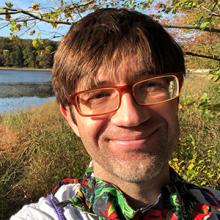Nobel Prize For Physiology or Medicine Awarded Today: Fun Facts and Multimedia (Updated)

(Inside Science) -- Early this morning U.S. East Coast time, Goran Hansson, secretary of the Nobel Committee for physiology or medicine, announced the winners of the 2014 prize: John O'Keefe, and jointly to May-Britt Moser and Edvard I. Moser. O'Keefe is from University College London, and the Mosers, who are married, are from the Norwegian University of Science and Technology, in Trondheim. They are the fifth married couple to win the prize, and the first since 1947.
May-Britt Moser is the 11th female winner of the medicine prize. For a more thorough breakdown of some of the stats of the Nobel Prizes in science, please take a look at our infographic, which covers the prizes for medicine or physiology, physics, and chemistry, from their inception in 1905 through 2013.
Audio
Edvard Moser was on a plane during the announcement, a member of the committee said.
Here's how Ian Sample, science editor from The Guardian reported that people were trying to figure out how to get word to the pilot.
— Ian Sample (@iansample) October 6, 2014
Eventually, the plane landed, and Adam Smith, from Nobel Media managed to obtain a lively interview, as mentioned here by Magnus Gylje, also from Nobel Media:
LISTEN “I didn’t understand anything.” Edvard I Moser on being awarded the Nobel Prize. #nobelprize2014 https://t.co/aVk3V0D4LL
— Magnus Gylje (@magnusgylje) October 6, 2014
Here are links to the interviews with May-Britt Moser and John O'Keefe.
Moser:
O'Keefe:
Also, here's Ian Sample's short interview with John Williams from the Wellcome Trust about O'Keefe.
John O'Keefe: a renaissance man who shoots hoops. My chat with John Williams at the Wellcome Trust: https://t.co/7kqKm19FqH #nobelprize2014
— Ian Sample (@iansample) October 6, 2014
The prize is in recognition of the brain's internal navigation system, made up of what are called grid cells and place cells. This isn't the first time Inside Science readers have encountered grid cells. In fact, new laureate May-Britt Moser commented on a paper by Elizabeth Buffalo from Emory University, and others, for this 2013 Inside Science News Service story from writer Eleanor Nelsen.
The Nobel Prize amount for 2014 is set at Swedish kronor 8.0 million per full Nobel Prize. That means the full prize is about $1.1 million.
Update: 2:00 p.m. EDT
In this update, I'll share some links and information about the two winners who share half the prize, May-Britt and Edvard I. Moser.
First, a video from the Norway University of Science and Technology showing May-Britt Moser celebrating her Nobel Prize win.
Here's a well-timed profile of the two from Nature, released just this week(!), which includes a passage that reveals how their research explained some longstanding mysteries regarding the link between memory and physical location:
These discoveries link the Mosers to a rich cast of scientists and philosophers who have pondered the connections between brain, memory and location since at least the time of Ancient Greece. Back then, a philosopher who needed to remember a long speech might memorize the layout of a building or a street, and mentally attach different parts of the speech to its different landmarks. He (they were almost always men) could then fluently deliver the entire rhetoric as he mentally walked around, allowing each landmark to activate the individual sections from memory. The fascination with memory and location continued into the twentieth century, when behavioural scientists first hypothesized that animals carry an abstract map of space inside their heads. The grid cells finally proved that this was true.
The New York Times profiled them in 2013.
Here's a passage from that piece, explaining how a change in their experiment made the discovery of grid cells possible:
And when they gave the rats enough room, a very regular pattern emerged.
“The first thing was that we thought there was something wrong with the equipment,” Dr. Edvard Moser said.
“I thought, ‘Is this a bug?’ ” Dr. May-Britt Moser said.
After a 2005 paper in Nature, in which they reported the discovery and named the cells, other labs confirmed the findings and more discoveries followed, in their lab and elsewhere.
Here's a video they recorded with the Times' science editor David Corcoran , also in 2013.
And one more video, in which the Mosers describe the part of the brain that includes the grid cells, the entorhinial cortex.
Also worth reading are the following:
A joint interview with the journal Current Biology in 2012.
An interview with Edvard Moser in 2005 from Science, from the perspective of building a career. Looks like that has worked out pretty well.
I'll be back with more in a little bit. In the meantime, check out our updated news story, for a full description of the science behind this prize.
Update: 3:00 p.m. EDT
According to reports from a press conference today in London, O'Keefe said that he's still an active researcher.
O'Keefe: "When I come into the lab I try to do science. I'm still a bench scientist." #nobelprize2014
— Ewen Callaway (@ewencallaway) October 6, 2014
And here he expands upon that, in an excerpt from an interview he gave upon receiving a different prestigious science prize earlier this year, the Kavli Prize in Neuroscience:
In terms of basic neuroscience, I think we're entering a really exciting era where recent technical developments will enable us to look not just at the activity of single neurons, but also at the way networks of neurons work together. We are arriving at the cusp of an era where we will have the ability to look at thousands of cells and monitor their activity in animals that are doing things in real environments or, more powerfully, in virtual reality environments. This is going to enable us to look at the way networks represent not only the animal's current location, but what it's thinking, how it's feeling, what it’s intending to do.
So, we’re optimistic that in the near future, coupling virtual reality environments to new recording techniques, we’ll be able to record from large numbers of cells and to see how the cells are interacting with each other.
And here's a nearly year-old press release about the 2013 Horwitz Prize, which O'Keefe also shared with the Mosers. It includes this sage nugget:
The Horwitz Prize is widely considered to be a precursor to a Nobel. Of the 91 Horwitz Prize winners to date, 43 have gone on to receive Nobel prizes. Most recently, James E. Rothman, PhD, a 2002 Horwitz Prize winner and adjunct professor of physiology & cellular biophysics at the Columbia University College of Physicians and Surgeons, shared the 2013 Nobel Prize in Physiology or Medicine.
Thanks so much for reading our news story and this blog today. We'll be back tomorrow with full coverage of the physics prize.

